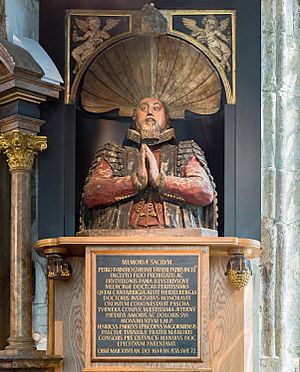Peter Turner (physician) facts for kids

Peter Turner (1542–1614) was an English doctor. He was known for following the medical ideas of Paracelsus, a famous thinker. Peter Turner was also a Member of Parliament in the 1580s, helping to make laws for England.
Contents
Early Life and Education
Peter Turner was the son of William Turner. His father was a church leader, a botanist (someone who studies plants), and had to leave England for a while during Queen Mary's rule. Peter's mother was Jane Auder. His father taught him about both religion and science.
After his father died, his mother married Richard Cox, who was a bishop. Peter Turner went to St John's College, Cambridge and earned his Master of Arts degree. He then studied medicine at Heidelberg in 1571, becoming a doctor. He also received doctor's degrees from Cambridge in 1575 and Oxford in 1599.
Medical Career
Peter Turner worked as a doctor in London. In 1582, he was allowed to practice by the London College of Physicians, a group that oversaw doctors. He was also set to become a doctor at St Bartholomew's Hospital. He took over from Roderigo Lopez there and was later followed by Timothy Bright.
Turner knew other important people in medicine and science. He met Thomas Penny in Heidelberg and went on trips with him to study nature. Another friend, Thomas Muffet, later wrote about Turner's work on Penny's notes about insects. Turner was part of a group of naturalists (people who study nature) in London. He was also known for using chemical treatments in his medical practice. Some important people he treated included Roger North, 2nd Baron North and Henry Brooke, 11th Baron Cobham.
Turner and his friends, including Muffet, Bright, and Penny, were doctors who followed the ideas of Paracelsus. They were interested in new ways of treating illnesses, often using chemicals. They worked somewhat separately from the main College of Physicians in London. When a German doctor named Valentine Russwurin, who also used Paracelsian methods, came to London, Turner went with him to learn more.
Time in Parliament
In politics, Peter Turner was chosen to represent Bridport in Dorset. He served in the English Parliament in 1584 and 1586. It is thought that Francis Russell, 2nd Earl of Bedford helped him get elected.
Turner was a strong supporter of the Puritans in Parliament. Puritans were a group who wanted to make the Church of England simpler. In 1584, he tried to introduce a new law. This law would have changed the church's structure to be more like the presbyterian polity (where local churches have more control). It also suggested a new way of worship, similar to what John Knox used. However, this bill did not pass.
Later Life and Legacy
In 1606, Turner looked after Sir Walter Ralegh when he was held in the Tower of London. Peter Turner died in London on May 27, 1614. He was buried near his father in St. Olave's, Hart Street church in London. His tomb was colorful, and it showed a statue of him kneeling in a red gown.
Writings
Peter Turner wrote a medical pamphlet called The Opinion of Peter Turner, Doct. in Physicke, concerning Amulets, or Plague Cakes in 1603. This pamphlet was a response to a work by Francis Herring. Herring had warned people against wearing "plague cakes" or amulets around their necks to prevent the plague.
Turner argued that the arsenic and orpiment (types of chemicals) found in these amulets could actually help against certain diseases. Herring, speaking for the College of Physicians, wrote a reply in 1604, disagreeing with Turner.
A song called A Spirituall Song of Praise was also thought to be written by Turner. It was added to a book by Oliver Pygge in 1589. This song was about praying for England's safety when the Spanish ships were near.
Family Life
Peter Turner married Pascha. She was the daughter of Henry Parry, who worked at Salisbury Cathedral. Pascha's brother was Henry Parry, who later became a bishop. Peter and Pascha had two sons who also became well-known: Samuel Turner became a doctor, and Peter Turner became a mathematician.

